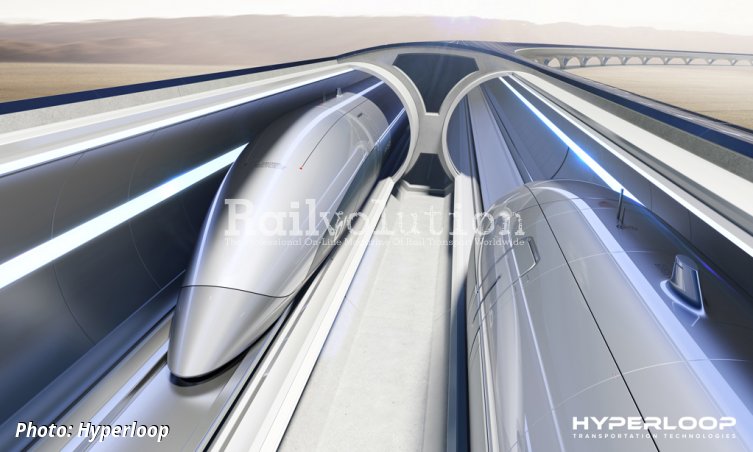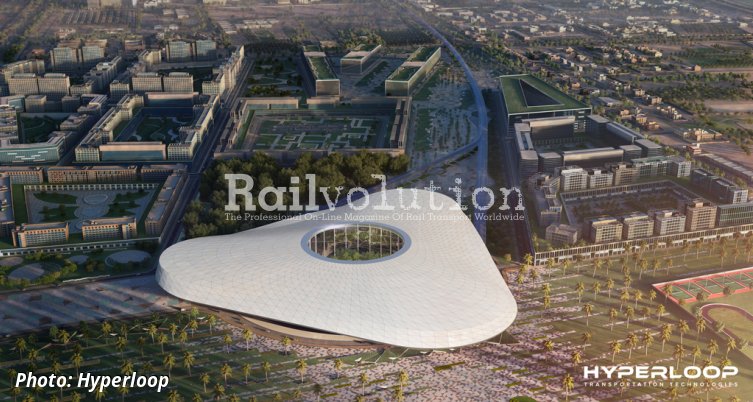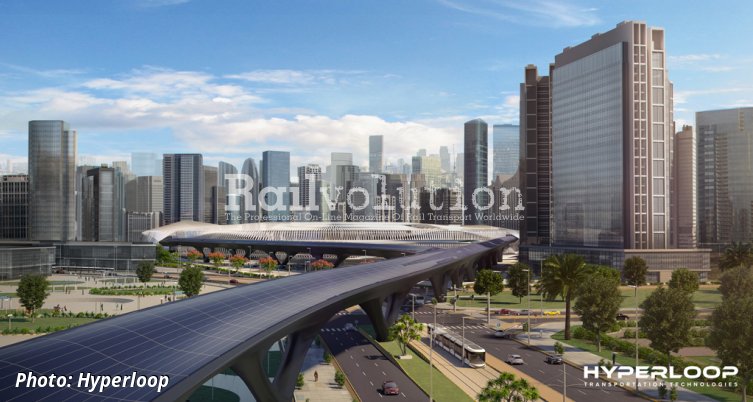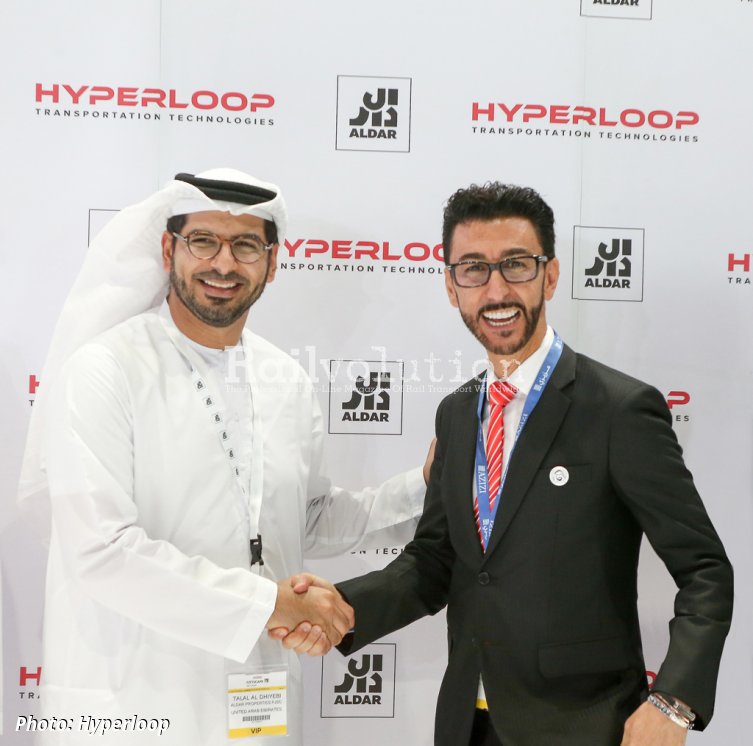Hyperloop - The Train-In-A-Vacuum-Tube Fantasy (5)
posted on 4th Mar 2020 18:30
Providing A Route For A Vacuum Tube
To build a vacuum tube for the transport of passengers at speeds of up to 1,200 km/h will require careful route planning. When conventional high speed railways with train speeds of 350 km/h are being designed (a superelevation of the track on the curves of 160 mm and a cant deficiency of 80 mm, with a total centrifugal acceleration of 1.57 m/s2 on curves), the usual minimum curve radius is around 6,000 m, which is necessary for the comfort of passengers.
But in a vacuum tube, where speeds of up to 1,200 km/h are to be attained, it would be necessary to ensure that curves had a minimum radius of 71,000 m to ensure that passengers enjoy the same level of comfort. This might be acceptable in sparsely populated areas, such as deserts and tundra, and areas of low relief, but it would be impossible in densely populated regions or in mountainous districts, such as those found in Europe.
Care would also have to be taken regarding changes in gradient, or vertical curvature. On high speed lines the minimum radius of such vertical curves is 10,000 m. On a 1,200 km/h vacuum tube system it would have to be at least 118,000 m. To ensure such gentle curvature in many places it would be necessary to lay the tube either on viaducts or in tunnels, and this would be extremely costly.
It would obviously be possible to build a vacuum tube line with lower levels of travel comfort, and let both vehicles and passengers be subjected to greater forces - vertical, longitudinal and transversal. But in such a case it would no longer be possible to regard the vacuum tube and high speed railway as comparable transport systems.
Moreover, nowadays there is a growing tendency for people to make more active use of travel time when using public transport. This could involve consuming refreshments, or using the vehicle as an extension of the office, for working purposes. Comfort, convenience and smoothness of ride all play a part here. But a reduction in travel comfort through compromising infrastructure parameters might result in a vehicle which was not suitable for such activities, and might even involve passengers having to be restrained in their seats through the use of airline-style seatbelts.
Heat Expansion Of Tubes
Railways are designed for use under a wide range of climatic conditions, including huge ranges of temperature. The track bed (either ballasted track or ballastless track) provides a high lateral stability for long lengths of continuously welded rail. This ensures that the compressive longitudinal forces caused by the thermal expansion of the rails are compensated for. This is not the case with metal tubes laid on low pylons.
A steel tube 200 km long, for instance, would expand in length by 176 m in a temperature range of -30 °C (winter) to +50 °C (summer). This thermal expansion and contraction must be compensated, otherwise the tube will buckle. In long distance pipelines, of the type used fore the transport of gases, Omega compensators are used (these are omega-shaped humps or curves placed at intervals along the pipe). But these are, of course, impractical for a vacuum tube used for high speed passenger transport. Thus, the technical solution of thermal expansion is one of the most important and complicated tasks of the considered vacuum tube.
Preventing Implosion
Although the compressive forces acting on a vacuum tube (at up to 0.1 MPa) are relatively small compared with the compressive forces acting on a conventional pipeline being used for the movement of compressed air (overpressure about 1 MPa), there exists a risk in the case of a vacuum pipeline becoming unstable and warping. This is caused by the pipe walling not being subjected to tension by the internal vacuum, as occurs with compressed air pipelines, but by being subjected to pressure. This can result in buckling. The difference between these two strains can be easily tried on a beer can: it is not easy to tear it by pulling the opposite walls, but it can be easily compressed and flattened.
This is a phenomenon which also occurs, infrequently, on railways, as the result of incorrect working practices. When a tank wagon is being emptied of its hot payload, the empty tank can implode while its enclosed interior is cooling down. This results from the relatively low vacuum, much smaller than the overpressure normally used for filling tanks.
For safety purposes, therefore, vacuum tubes for use by vehicles must be designed so that they are completely rigid, and not prone to imploding. They must be properly solid and laid flexibly to prevent the walls of the tube from bulging, which is then followed by catastrophic cascading collapse. This is a fundamental issue in order to maintain the loading gauge, and hence the clearance for vehicles.
A complete caption for picture 1: The first commercial Hyperloop line is being built in the United Arab Emirates, a 150 km line linking Abu Dhabi and Dubai in readiness for Expo 2020, according to a press release dated 5 June 2018 issued by Hyperloop Transportation Technologies and Dubai-based Aldar Properties. It was announced in January 2019 that the first 10 km stretch of tube would be completed by 2020, following the start of construction in autumn 2019. Line A will then connect Abu Dhabi and Dubai, Line B will run from Al Ghadeer to Yas Island and Abu Dhabi, and Line C from Jebel Ali Port to Al Maktoum International Airport.
A complete caption for picture 2: The Dubai to Abu Dhabi Hyperloop project also includes the development of Hyperloop TT’s XO Square Innovation Centre and Visitor Centre in Abu Dhabi. This photo was taken on 18 April 2018 during the signing of the agreement for development of the project. On the left is Aldar Properties executive director Talal Al Dhiyebi, and on the right Board Chairman and co-founder of Hyperloop TT, Bibop Gresta. The XO Square and visitor Centre are to be situated on land owned by Aldar Properties, close to the Alghadeer residential area, not far from the border between the Abu Dhabi and Dubai Emirates. It is also near the Expo 2020 exhibition centre and Dubai’s Al Maktoum International Airport.
The article will continue.





